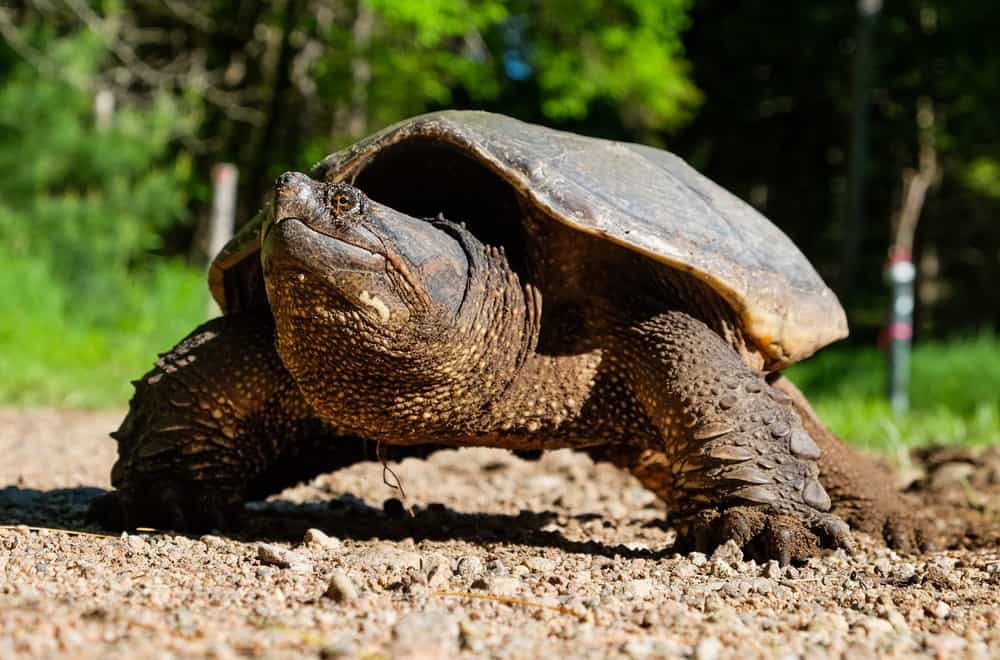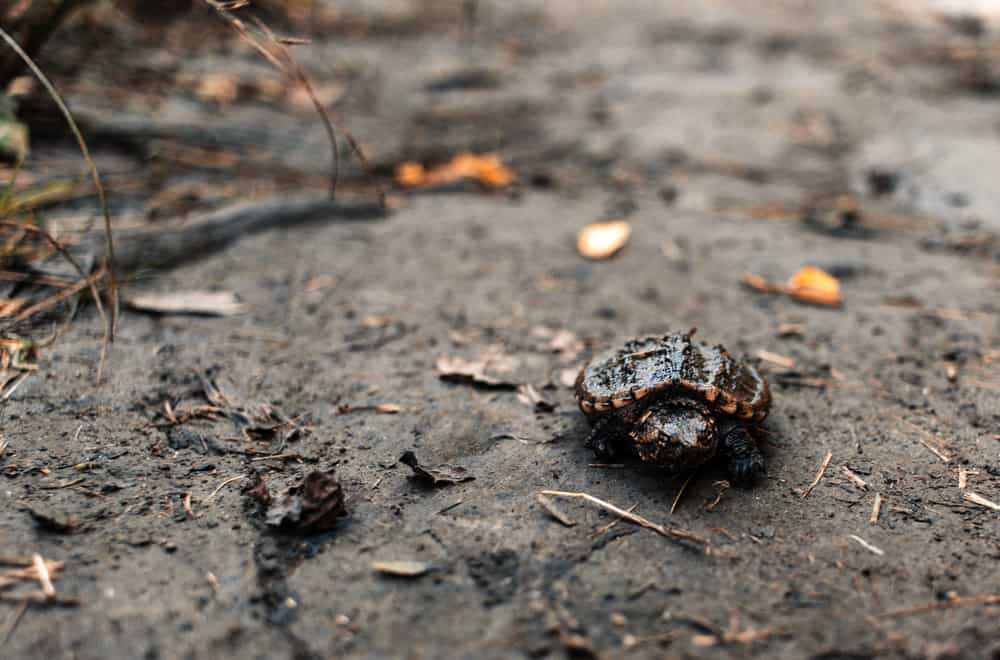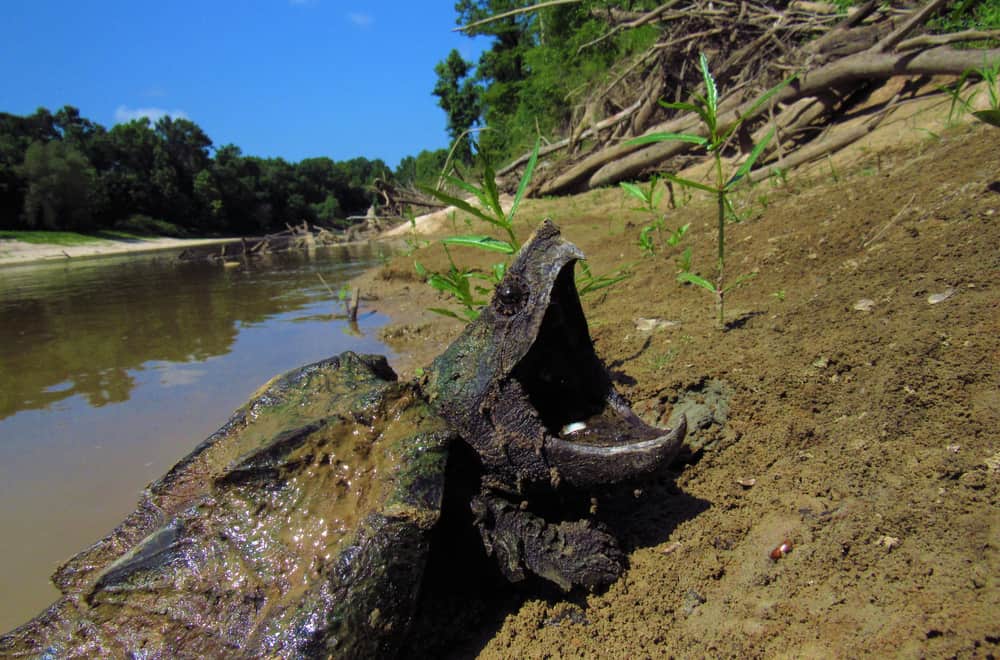Snapping turtles are large reptiles with long-tail and elongated snouts, like a beak. Many people are aware that these animals have a strong bite and a tendency to snap their jaws. You can distinguish two snapping turtle types that feed similarly, but their catching food methods are different. So, let’s see what do snapping turtles eat.
Snapping Turtles Habits and Biology
Snapping turtles are large water reptiles that live in freshwater environments, such as lakes, swamps, rivers, and streams. You will find their habitats in southeastern Canada, Nova Scotia, southwestern Rocky Mountains, and Florida.
When found in water, they are usually hidden in mud or sand and can hide among the aquatic plant roots at the bottom. When you see a Snapping turtle coming out of the water, it is wise to pay attention to its combativeness. It is not uncommon for this creature to bite a human in a direct encounter.
Snapping turtle types |
||
| Traits | Common Snapping turtle | Alligator Snapping turtle |
| Scientific name | Chelydra serpentina | Macrochelys temminckii |
| Diet | Omnivorous | Carnivorous |
| Weight | 10 to 35 pounds (4.5 – 16 kg) | Up to 175 pounds (79.5 kg) |
| Length | 8 to 14 inches (20 – 36 cm) | 26 inches (67 cm) |
| Lifespan | 40 years | 70 years |
| Conservation status | Low concern | Vulnerable |
There are two snapping turtle types that belong to the same family, but they look entirely different. For instance, the largest Alligator Snapping turtle had an impressive 249 pounds (113 kg), while the biggest Common Snapping turtle weighed only 75 pounds (34 kg).
Common Snapping turtle
The Common snapping turtle shell is black, brown, or olive. You can often see algae growing on its back, providing good camouflage. Its head is dark, while the neck, tail, and legs are yellow. They also have a protrusions series on their neck and legs.
Common Snapping turtle has a nose on its head’s top, so it is necessary to expel only a head’s small part from the water while breathing. Since this animal is too big, it can’t tuck its head into its body like other turtles to protect itself.
Alligator Snapping turtle
The Alligator Snapping turtle carapace is dark brown. The upper shell side is often overgrown with algae, just like in Common Snapping turtles. Thanks to three spikes rows on the shell that reminded people of alligators, the entire species got the name after that body part.
This turtle type has a large head with a strong jaw, while its eyes are set wide on both head sides. The legs are short, and there is a swimming foreskin between the toes. Be careful while handling this creature since long claws on its fingers can be pretty dangerous.
Do Snapping Turtles Eat Dirt?
Common Snapping turtles are omnivores, while Alligator Snapping turtles are primarily carnivores. As they feed, you can feel like they chew the earth and dirt.
However, these reptiles actually sift through the ground while eating and separate insects and other small animals from dirt during this process. Turtles are clean animals, and they avoid eating any dirt, sand, and earth.
What Do Snapping Turtles Like to Eat Most
The Snapping turtles’ diet can vary, but they are mostly omnivores. Since they spend most of the time in and next to the water, you can expect that aquatic vegetation participates in their diet.
On the other hand, they will enjoy eating fish mainly present in the turtles’ regular diet. Remember that Snapping turtles are not agile and fast swimmers, so their prey is usually slow swimming fish, eels, and water snakes.
These two turtle types catch their prey differently. Alligator Snapping turtle usually sits motionless in the water, hidden behind plants, and waits for prey with mouth open. Its tongue looks like a worm, and the turtle uses it as bait. As soon as an animal or fish bites, the turtle quickly closes its jaws.
Common Snapping turtles don’t have teeth, and their tongues are not in the worm shape. Therefore, they can’t use them as bait. This species has strong jaws that allow it to feed on small fish, amphibians, birds, and plants.
Also, you can see it eating dead animals and even other turtles. When Common Snapping turtle catches another turtle, it bites off its head first as a sign that it has defended its territory.
Since both Snapping turtle types are meat lovers, I will give you a list of some water animals and insects they are happy to eat:
- Crab and shrimps
- Tuna, sunfish, and goldfish
- Tadpoles and frogs
- Snails, worms, and mealworms
- Leeches
- Cockroaches, dragonflies, and ants
- Salamanders, smaller turtles, and adult turtles
- Water snakes and snakes
- Cattails
Also, these turtles can ingest:
- Bird eggs
- Ducks and ducklings
- Goose and goslings
- Swans and cygnets
- Chickens
- Raccoons, squirrels, rabbits, and beavers
- Rats
When they are hungry, you can expect these reptiles not to choose what to eat. They can nibble from morning to dark in such a situation, although they usually feed at night. In a case when you feed a Snapping turtle as a pet, you can also offer it:
- Raw chicken meat
- Raw beef meat
- Raw bacon
Remember that it is crucial to enrich your pet’s diet with vegetables and fruits. You can offer your turtle:
- Tomato
- Carrots
- Corn
- Celery and lettuce
In addition to all this, treat your snapping turtle to fruit. Feel free to enrich its diet with:
- Apples and peaches
- Bananas and pineapple
- Strawberries, blueberries, and blackberries
- Cherries
- Watermelon
Naturally, Snapping turtles often consume and a wide plant range, including:
- Algae
- Grass and Boss moss
- Water lilies and Water hyacinth
- Water fern and Water salad
- Hydrilla and Mermaid weed
The fact is that a snapping turtle will eat anything it finds, whether it is in its natural environment or you keep it as a pet in a tank.
Food Avoid to Feed Snapping Turtles
Believe it or not, your Snapping turtle will refuse to eat any food it finds tasteless and unattractive. It will consume only visually and fragrantly appealing ingredients.
The best option is to offer your pet food it usually eats in the wild since this species won’t accept any experimenting when it comes to its meal. The first thing to do when seeing uneaten food is to make it look better.
Snapping turtles can’t eat oversized pieces of hard food because this particular reptile doesn’t have teeth. Therefore, you need to chop and shred fruit and veggies into pieces and soak the commercial pellets before offering them.
Never give processed food to your pet since it can be harmful to its health. Forbidden ingredients include:
- Bread, crackers, and pasta
- Dairy products (milk, cheese, yogurt) may cause health issues since Snapping turtles can’t digest dairy products
- Raw meat and hamburgers that quickly rotten before your pet manages to eat them
- Sausages, bacon, and salami will lead to illness because containing too many additives, salt, sugar, and artificial colors
- Chips packed with salt
Avoid offering food caught in the wild to your pet since it often contains unknown pathogens and parasites. Raw food from a reputable pet store is thoroughly checked, so you can treat your turtle with healthy fish, shrimps, and worms it will adore.
Tips to Feed Snapping Turtles
Snapping turtles are a bit weird animals with unusual behavior and eating habits. Luckily, they are not picky eaters and can consume anything that is appealing to their criteria. It will be enough to create a balanced diet to keep these animals healthy and satisfied.
- Keep in mind that Snapping turtles are messy animals, so you shouldn’t leave food at their disposal all the time.
- Feed your pet in a small separate container and put it back in its space after feeding. Otherwise, you will see it defecate over food and spend time cleaning it.
- Take care to offer your Snapping turtle live food necessary for its digestion and waking its instincts. However, there is no need to provide proteins to it more than once in two to three days.
- Don’t forget to add some supplements to the turtle’s diet, particularly vitamin D and required minerals when needed. Plus, always cut foods into small, bite-sized pieces to make eating effortless for this animal without teeth. It is particularly crucial when you have baby turtles.
- Don’t panic if your Snapping turtle stops eating at once. The first thing to do is to check its environment. Be aware that your pet won’t consume food offered in filthy water. The second common problem is the right temperature. Keep in mind that this cold-blooded reptile can’t produce its own heat. So, it will probably refuse to nibble when the water is too cold.
- In the end, deal with it that your pet is not a vegetarian! It needs meat, and a lack of proteins will kill it for sure. Be prepared that it will turn your life into a mess since an unhappy and hungry Snapping turtle will become destructive. Everything you need to do is feed it. Just do it!
Summary
Snapping turtles eat whatever they find in nature, depending on the region where they live. These omnivores’ diet primarily includes aquatic vegetation, slow fish, eels, water snakes, crayfish, frogs, amphibians, worms, and insects. Never allow your pet to stay hungry since you will regret it immediately.



I enjoyed reading your info on snapping turtles. Mine is a quarter size baby snapper but I still can’t figure out what kind. I want to keep him as healthy as possible so I want to make sure I have all the essential things that you need to have for him to do that. Thank you
A common snapping turtle in my pond, is very fond of pellet fish food. It comes up for food at every feeding. Should I be concerned about over feeding an adult snapper? It tends to keep feeding as long as the pellets are available.
Great help alot project